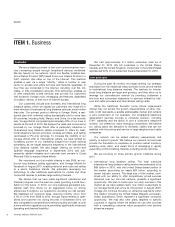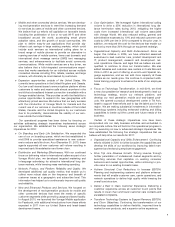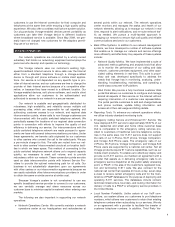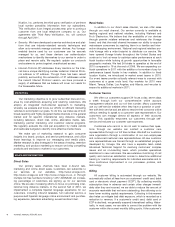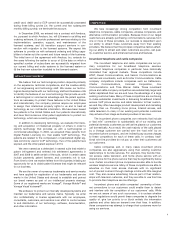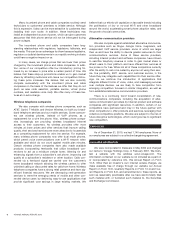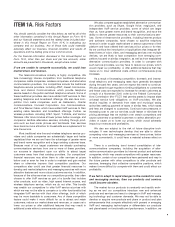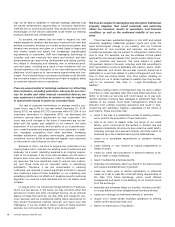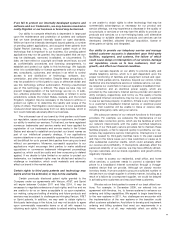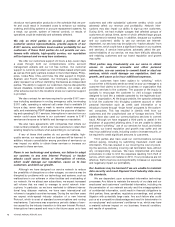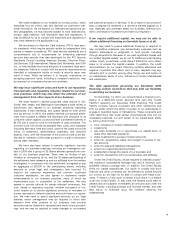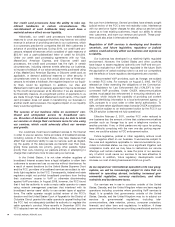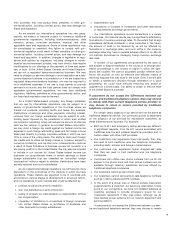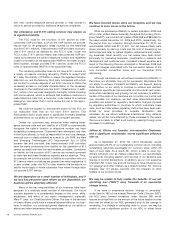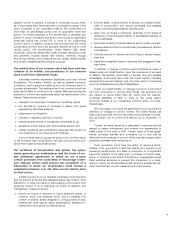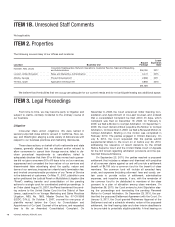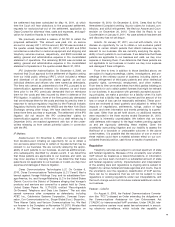Vonage 2010 Annual Report Download - page 16
Download and view the complete annual report
Please find page 16 of the 2010 Vonage annual report below. You can navigate through the pages in the report by either clicking on the pages listed below, or by using the keyword search tool below to find specific information within the annual report.
ITEM
1
A.
Risk Fac
t
o
r
s
You should carefully consider the risks below, as well as all of th
e
other information contained in this Annual Report on Form 10-K
a
n
dou
r fin
a
n
c
i
a
l
s
t
a
t
e
m
e
nt
sa
n
d
th
e
r
e
l
a
t
ed
n
o
t
es
in
c
l
uded e
l
se-
where in this Annual Report on Form 10-K, in evaluatin
g
ou
r
compan
y
and our business. An
y
of these risks could materiall
y
a
dversel
y
affect our business, financial condition and results o
f
operations and the tradin
g
price of our common stock.
F
or the
f
inancial in
f
ormation discussed in this Annual Re
p
ort on
F
orm 10-K, other than
p
er share and
p
er line amounts, dolla
r
a
mounts are
p
resented in thousands, exce
p
t where noted
.
If we are unable to com
p
ete successfull
y
, we could los
e
mar
k
et s
h
are an
d
revenue.
T
he telecommunications industry is hi
g
hly competitive. We
face increasin
g
ly intense competition from traditional telephone
com
p
anies, cable com
p
anies, wireless com
p
anies, and alternative
communication
p
roviders.
O
ur com
p
etitors include the traditiona
l
t
elephone service providers, includin
g
AT&T,
Q
west
C
ommunica
-
t
ions, and Verizon
C
ommunications, which
p
rovide tele
p
hon
e
s
ervice based on the
p
ublic switched tele
p
hone network.
S
ome o
f
t
hese traditional
p
roviders also have added VoIP services to thei
r
existin
g
telephone and broadband o
ff
erin
g
s. We also
f
ace com
-
p
etition from cable com
p
anies, such as Cablevision, Charter
C
ommunications, Comcast Cor
p
oration, Cox Communications
,
and Time Warner Cable, which have added VoIP services to thei
r
existin
g
cable television and broadband o
ff
erin
g
s. Further, as
wireless providers, includin
g
AT&T, Sprint, T-Mobile, and Verizon
Wireless, o
ff
er more minutes at lower prices, better covera
g
e, and
companion landline alternative services, includin
g
throu
g
h prod
-
ucts such as dual mode
p
hones and
f
emtocells, their services
have become more attractive to households as a re
p
lacement
f
or
wir
e
lin
ese
rvi
ce.
M
ost tra
di
t
i
ona
l
w
i
re
li
ne an
d
w
i
re
l
ess te
l
ep
h
one serv
i
ce pro-
vid
ers an
d
ca
bl
e compan
i
es are su
b
stant
i
a
ll
y
l
arger an
db
etter
capitalized than we are and have the advantage o
f
greater name
an
db
ran
d
name recogn
i
t
i
on an
d
a
l
arge ex
i
st
i
ng customer
b
ase.
Because most o
f
our target customers are already purchasin
g
communications services
f
rom one or more o
f
these providers
,
our success
i
s
d
epen
d
ent upon our a
bili
ty to attract target
customers away from their existing providers.
O
ur competitors
’
financial resources ma
y
allow them to offer services at prices
b
elow cost or even for free in order to maintain and gain market
s
hare or otherwise improve their competitive positions.
O
u
r
competitors also could use their greater financial resources t
o
d
eve
l
op an
d
mar
k
et te
l
ep
h
ony an
d
messag
i
ng serv
i
ces w
i
t
h
more
attractive features and more robust customer service. In addition
,
b
ecause of the other services our competitors provide, the
y
ofte
n
choose to offer VoIP services as part of a bundle that includes
ot
h
er pro
d
ucts, suc
h
as v
id
eo,
hi
g
h
spee
dI
nternet access, an
d
wireless telephone service, which we do not offer. This bundle
ma
y
enable our competitors to offer VoIP service at prices wit
h
which we ma
y
not be able to compete or to offer functionalit
y
that
i
ntegrates VoIP service with their other offerings, both of whic
h
ma
y
be more desirable to consumers. An
y
of these competitiv
e
factors could make it more difficult for us to attract and retai
n
customers
,
re
d
uce our mar
k
et s
h
are an
d
revenues
,
or cause us t
o
l
ower our prices or offer additional features that ma
y
result i
n
a
ddi
t
i
ona
l
costs w
i
t
h
out commensurate pr
i
ce
i
ncreases
.
We also compete against established alternative communica
-
t
ion providers, such as
S
kype,
G
oo
g
le Voice, ma
g
icJack, and
i
ndependent VoIP service providers, some of which are lar
g
e
r
t
han us, have
g
reater name and brand reco
g
nition, and have th
e
ability to devote
g
reater resources to their communications serv
-
i
ces.
S
ome of these service providers, includin
g
Internet product
and software companies, have chosen to sacrifice telephon
y
revenue in order to
g
ain market share or attract customers to their
p
lat
f
orm and have o
ff
ered their services at low
p
rices or
f
or
f
ree.
A
s we continue the introduction o
f
applications that inte
g
rate di
f
-
f
erent
f
orms o
f
voice, video, and messa
g
in
g
services over multipl
e
devices, we are likely to
f
ace competition
f
rom emer
g
in
g
com-
petitors
f
ocused on similar inte
g
ration, as well as
f
rom establishe
d
alternative communication
p
roviders. In order to com
p
ete wit
h
such service providers, we may have to reduce our prices, which
w
ould impair our pro
f
itability, or o
ff
er additional
f
eatures that ma
y
cause us to incur additional costs without commensurate
p
ric
e
i
n
c
r
eases.
As a result o
f
increasin
g
competition, domestic and interna
-
t
ional telephony and messa
g
in
g
rates have
g
enerally decreased
durin
g
the past
f
ew years, and we expect this trend to continue
.
We also pass throu
g
hre
g
ulatory
f
undin
g
obli
g
ations to customer
s
and these costs are ex
p
ected to increase
f
or certain customers a
s
a result of a November 2010 order by the Federal Communica
-
t
ions Commission
(
the “FCC”
)
that
p
ermits states to im
p
ose state
u
niversal service
f
und obli
g
ations on VoIP providers. We also
receive inquiries or demands
f
rom state and municipal taxin
g
authorities seekin
g
payment o
f
taxes or similar
f
ees, which taxes
and fees are char
g
ed to customers. Continued rate pressures or
i
ncreas
i
n
g
cost to use our serv
i
ces cou
ld l
essen or e
li
m
i
nate t
h
e
pr
i
c
i
ng a
d
vantage t
h
at we ma
i
nta
i
n over certa
i
n compet
i
tors an
d
cause customers or potent
i
a
l
customers to se
l
ect a
l
ternat
i
ve pro
-
v
id
ers or cause us to
l
ower our pr
i
ces, w
hi
c
h
wou
ld
a
d
verse
ly
i
mpact our revenues and pro
f
itabilit
y.
We also are subject to the risk o
ff
uture disruptive tech-
n
ologies. I
f
new technologies develop that are able to deliver
compet
i
ng vo
i
ce an
d
messag
i
ng serv
i
ces at
l
ower pr
i
ces,
b
ette
r
or more convenientl
y
, it could have a material adverse e
ff
ect on
us.
T
here is a continuing trend toward consolidation o
f
tele-
communications companies, including the acquisition o
f
alter-
n
ative communication providers b
y
Internet product and so
f
twar
e
compan
i
es, w
hi
c
h
may create compet
i
tors w
i
t
h
greater resources.
I
n addition, certain o
f
our competitors have partnered and ma
y
in
t
he future partner with other competitors to offer products an
d
serv
i
ces,
l
everag
i
ng t
h
e
i
rco
ll
ect
i
ve compet
i
t
i
ve pos
i
t
i
ons, w
hi
c
h
m
akes it more difficult to compete with them and could affect ou
r
profitabilit
y.
If we fail to adapt to rapid chan
g
es in the market for voice
an
d
messag
i
ng serv
i
ces, t
h
en our pro
d
ucts an
d
serv
i
ce
s
cou
ld b
ecome o
b
so
l
ete.
T
he market for our products is constantl
y
and rapidl
y
evolv
-
i
ng as we an
d
our compet
i
tors
i
ntro
d
uce new an
d
en
h
ance
d
p
ro
d
ucts an
d
serv
i
ces an
d
react to c
h
anges
i
n
V
o
IP
an
d
messag-
i
ng tec
h
no
l
ogy an
d
customer
d
eman
d
s.
W
e may not
b
ea
bl
et
o
d
eve
l
op or acqu
i
re new pro
d
ucts an
d
p
l
ans or pro
d
uct an
d
p
l
a
n
enhancements that compete effectively with present or emergin
g
VoIP and messaging technologies or differentiate our products
and plans based on functionalit
y
and performance. In addition, w
e
9





